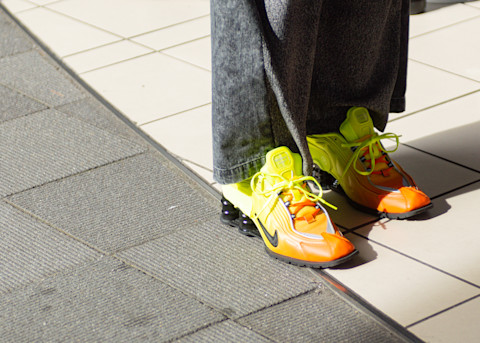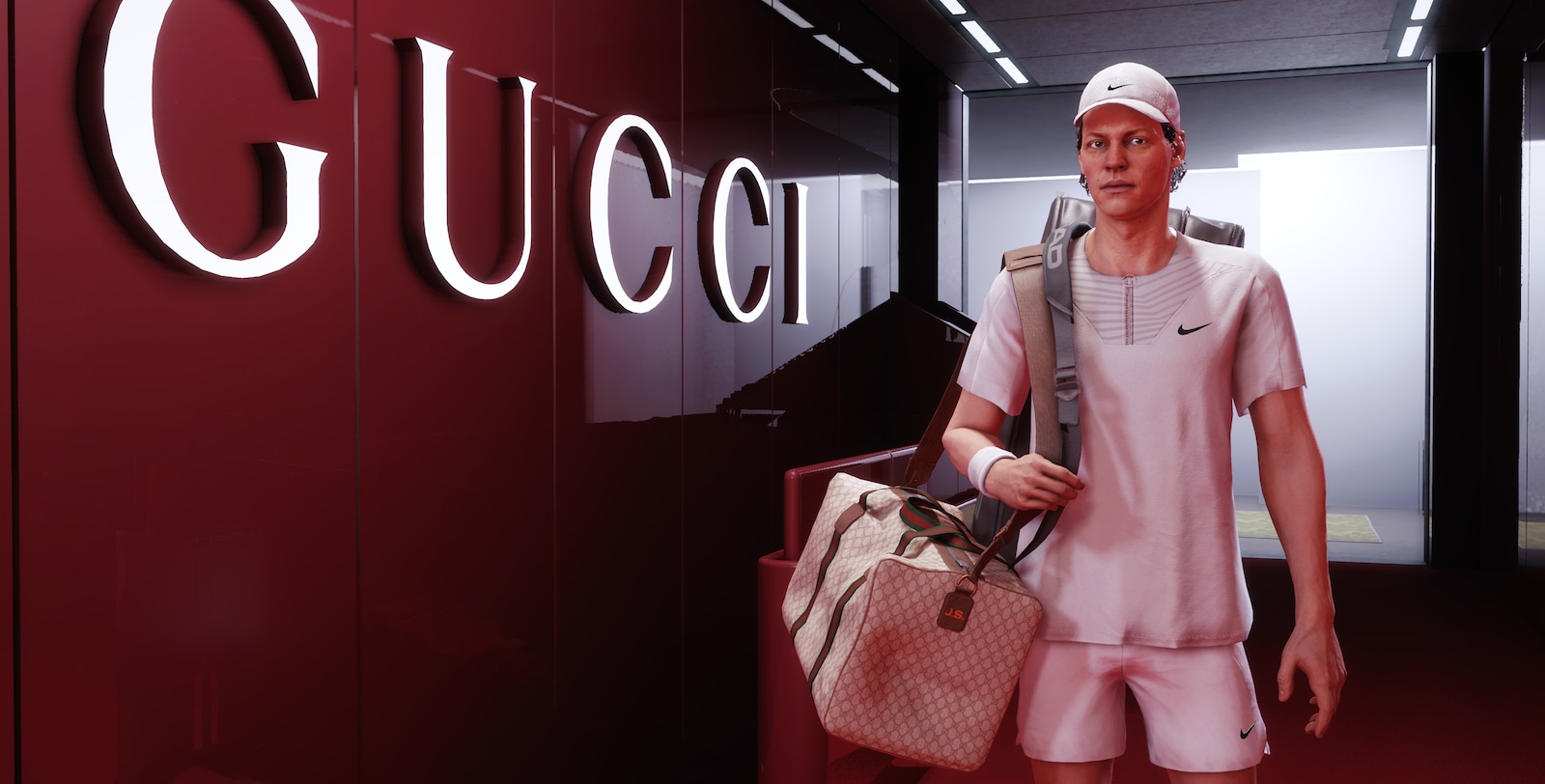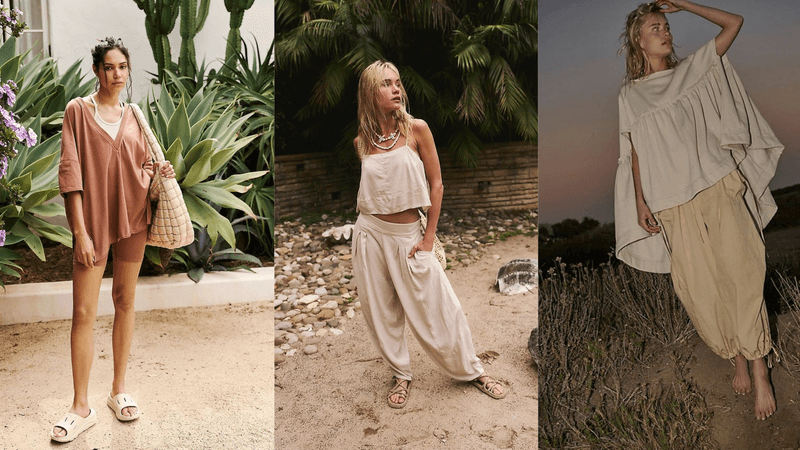The Era of the Frankenshoe
From the infamous New Balance “snoafer” to Kiko Kostadinov’s futuristic brogued runners, the era of the Frankenshoe is now, but why?

Back in January, the first images of a new shoe lit up sneaker blogs and Instagram mood board pages alike. It had a classic mesh upper and a comfortable-looking sole unit, but then there was the leather saddle across the front and a slip-on design at the back. The shoe was a hybrid half-sneaker, half-loafer created by New Balance and dubbed the 1906L. Predictably, the shoe gained a nickname: the “snoafer.” This new mutant spread across the world, inspiring conversations and think pieces. The Wall Street Journal called it “the footwear equivalent of the spork,” while GQ hit a note of surprise, describing the so-called snoafer as “a viable footwear option first, and a meme second.”
While the snoafer came as a shock, it was based on an overlooked period in the ’80s and ’90s during which New Balance made boat shoes and brogues alongside its better-known sneaker offerings. Building on these previous designs—and New Balance’s other releases—designer Charlotte Lee told the Wall Street Journal that the brand felt like a company that could “blend between many lines.” With its athletic and formal influences, its mix of work and play, the snoafer seems to blur pretty much every line.

New Balance’s newest silhouette—which was originally launched as part of a collaboration with Junya Watanabe for Fall/Winter 2024—is far from the first Frankenshoe to be released, or, in fact, to be a viral hit. In recent years, we’ve seen Maison Margiela’s collaboration with Reebok—all tabi toes and classic uppers—as well as Martine Rose’s take on the Nike Shox MR4, which combined a much-loved sneaker silhouette with a pointy toe, high heels, and a mule construction. Then there are older examples, including the visvim FBT, which features a moccasin upper atop a sneaker outsole; the ever-controversial informal-formal crossover of the America’s Cup Sneaker by Prada; or editions from Margiela that supplement athletic silhouettes with brogueing.

A Frankenshoe is a fusion of two or more silhouettes, often splicing designs from opposite ends of the footwear spectrum. In the past, they have mainly been attempts to bring the comfort of sneakers to the world of office-appropriate dress shoes. A comfortable, lighter alternative that you can wear to work, without your boss realizing that your shoes are, in fact, not a regulation pair of Oxfords or derbys. This breed of Frankenshoe still exists in offices across the world as a grubby compromise that manages to satisfy no one, not yet consigned to the dustbin of #menswear’s darkest days.Nowadays, though, Frankenshoes have gotten even weirder. There are sneakers turned into dress shoes and dress shoes turned into sneakers. There are even, in the case of Comme Des Garçons Homme Plus, shoes shaped like each contains two feet. We are living in a veritable golden age for the Frankenshoe, surrounded by new releases of mix-and-match footwear. Whether you like them or not, they’re still being released, still being discussed and, crucially, bought.If this new era had to be traced back to a single point, it’d likely be the launch of Balenciaga’s Triple S in 2017. The huge, exaggerated shoe—which looked like a hybrid of three different designs on its sole alone—immediately became a hit. Even if you didn’t like the shoe, you had an opinion on it. Under Demna’s direction, Balenciaga has repeatedly found virality with moments like this. As Tora Northman notes, virality is fashion’s latest currency, and Balenciaga is showing “what happens when the product itself becomes the real advertising.”Since the Triple S, Balenciaga has followed this formula on a number of its footwear releases. There have been high-heeled versions of Crocs and Vibram 5-Toes, tote bags made out of La Cagole boots, and the 10XL Sneaker, which sits atop a 6-inch platform made up of ten distinct sole units. The result is a kind of stratigraphic drawing of previous sneakers. The journey from Triple S to 10XL has also included the 3XL and the Cargo, two more sneakers that push size and scale to the extreme. All of these shoes have been discussed and debated, derided and adored by Balenciaga-watchers and the wider world.

As well as their exaggerated size, one thing these Balenciaga releases all have in common is their virality. By pushing things further—adding layer upon layer of sneaker, 6 inches of sole, mashing up completely different silhouettes—the house has shown how Frankenshoes can reach as many eyes as possible. Whether Balenciaga’s Triple S provoked positive or negative reactions wasn’t the question at hand. The main thing is that it provoked reactions at all. Similarly, New Balance’s snoafer inspired jokes and discussions from the moment it hit Instagram in the form of in-hand sample shots, months before the shoe had even hit stockists. You might have loved the hybrid sneaker-loafer, or you might have hated it, but articles were commissioned and memes were made. The hope is that people will still be talking about them when they finally launch later this year.With their propensity to influence conversation and inspire memes, these hybrid shoes are just the latest stage of the hype cycle of sneakers. For every viral hit or must-have sneaker, there are thousands of releases that vanish into the ether. While once it might have been a limited-edition rerelease or a new colorway that got people talking, now the way to move the dial is something more extreme, something altogether freakier than a new upper or a cobranded label. By pushing the envelope, brands are hoping to reach an audience beyond their already devoted fans.There are parallels to be drawn with MSCHF’s Big Red Boots, which set the internet alight when they launched last year. The shoes were mocked, partly for their appearance and partly for their impracticality, but MSCHF was always in on the joke. The Big Red Boots were just the latest project from the art collective, which has been the architect of its own notoriety by disrupting the fashion industry with satirical drops. Laid bare, MSCHF’s approach isn’t all that different from Balenciaga’s. Sure, the Demna-led label’s shoes are made to be worn, but by creating 10XL shoes, or putting high heels on Crocs, the designer is also reflecting the excesses of hype culture more widely.

The desire for a hybrid shoe goes beyond the outlandish and intentionally viral. London label Kiko Kostadinov has integrated various influences into single shoes for its current womenswear collection, which includes slip-on brogues and “Hybrid” ballerina flats. Laura and Deanna Fanning, the duo behind Kiko Kostadinov’s womenswear, have often pursued this hybrid approach. Their aesthetic has previously been described as a fusion of details from across the fashion spectrum, and their viral Ribbon Boots show the success they’ve had with it.This approach comes, in part, because of the pair’s lack of training in creating footwear. “We are not classically trained footwear designers, which in a way allows us to approach footwear with a bit more freedom than other pieces in the collection,” Laura and Deanna explain over email. Free from the constraints of what people normally do, and what fashion history dictates you should do, the pair has been able to throw diverse influences—from floral buckles on boxing boots to brogue detailing on slip-on shoes—into one silhouette. The result ties in with other themes in their designs. “We generally work on material contrasts—knit and woven, soft and hard for example,” they explain. “In this way, the footwear uses the same methodology of contrasts in the hope of proposing something new for our wearer.”

Similarly, Martine Rose has used the mash-up approach to explore and reinvent new codes. Whilst launching her Nike Shox collaboration, the London-based designer discussed the cultural significance of the silhouette in the UK: “It’s always been an underground shoe that everyone has worn,” she told Vogue, posing the simple question: “How can we make a trainer a smart shoe?”Other brands echo the power of combining unlikely influences into a single shoe, taking this approach to reinvent familiar silhouettes. Swedish label EYTYS, for example, introduced the Marcello shoe in its latest collection, adding a “blowfish-inspired” technical sole unit to a pair of classic boat shoes and creating something sculptural out of a staid, preppy staple. DEMON, on the other hand, has been using architectural sole units to blur the lines between Alpine-hiking footwear and the brand’s avant-garde taste.Speaking about the design process behind each DEMON silhouette, the brand’s creative director, Alberto Deon, highlights a rough formula. “I try to maintain a balance of 70% avant-garde and 30% heritage,” he explains. “But the goal is to blend the two into a seamless composition.” At this level, that’s the perfect ambition of any hybrid shoe. Two different poles of inspiration combine to create something new and exciting: a product that is more than the sum of its parts.

For Deon, this approach is reinforced by a particular focus on details—he mentions architect Ludwig Mies van der Rohe’s idea that “God is in the details.” In his belief that details are pivotal to DEMON’s designs, Deon outlines a shared feature of all Frankenshoes. From viral sneakers to reinvented hiking boots, all of these shoes differ in scope and in execution, but the key thing they have in common is the use of new details and added adornment. Extra details and new functionalities create maximalist footwear. Interestingly, this has happened alongside an equally powerful but totally opposing trend. In recent years, we’ve seen the much-hyped (and endlessly discussed) rise of the Samba, the return of the Onitsuka Tiger Mexico 66, and the emergence of a supposedly post-sneaker world. Whether it’s archive sneakers or the return of loafers, it’s striking how simple each of these trends is. In recent seasons, minimal, vintage-inspired runners or preppy shoes have won out. Running parallel to that, though, we’ve seen a dramatic dichotomy in the rise of high-heeled Nike Shox mules and tabi-toed Reebok Classics.This return to maximalism has been described by Vanessa Friedman as “revenge” against the tyranny of quiet luxury, a resurgence of self-expression and decoration after a period of soft fabrics, neutral colors, and Loro Piana caps. This new take on maximalism is one that prioritizes the fun over the austere, the joyful over the serious. Speaking to The New York Times earlier this year, Marni creative director Francesco Risso touched on ideas such as “joy” and “celebration” that he was channeling with his work. What’s more fun than bright colors, floral details, or high heels on a pair of Nike Shox? As we made an emphatic and all-consuming return to rehashed, understated silhouettes and sneakers that were first released 75 years ago, some sort of backlash was inevitable.When you start looking, you can see the Frankenshoe’s footprints across the fashion industry, and it goes much deeper than a handful of meme-baiting silhouettes. They’re there in oversized Converse and a pair of teased adidas bowling shoes; you can see details in Simone Rocha’s beaded ballet flats and Dior’s hiking boots. Not all of them are as big and brash as Balenciaga’s more experimental designs, but they all speak to a burning desire for something more.

Maybe the reason we can’t quit the Frankenshoe is because of the novelty of the 10XL soles and exaggerated proportions, or maybe it’s because it guides us down refreshing new avenues of possibility with our footwear. When the Fannings talk about their footwear at Kiko Kostadinov, they talk about creating something new by contrasting different existing elements. This creativity is, in many ways, the essence of fashion design. By creating new, unclassifiable types of shoes, designers like the Fannings are allowing another avenue for self-expression, another route to redraw the boundaries of how we dress.Hybrid footwear sits outside the rigid definitions of sneakers or loafers, trainers or high heels. Taking elements from each—and, sometimes, from somewhere completely different—these designs allow us to land somewhere in the middle of those classifications. Somewhere more interesting, somewhere less confined and somewhere, hopefully, more fun.



